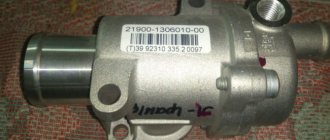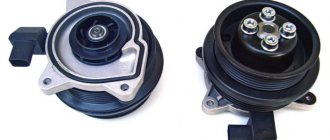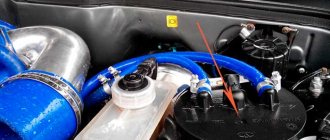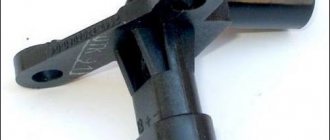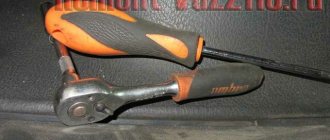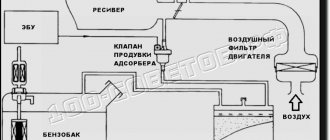Any engine requires cooling during operation. For this purpose, there are special channels in the block, and a thermostat is provided outside. The entire system is connected by pipes. Coolant circulation is ensured by a special water pump. People call it a pump. But that's not all. In order for the engine to warm up quickly, part of the liquid is forcibly “cut off” and does not circulate for a certain time. A thermostat is used to control coolant flows. Signs of its malfunction and the device are further in our article.
How it works?
Any engine uses two circuits:
Both contain coolant. However, after the engine starts, it heats up only in a “small” circle. This way the motor will quickly reach its operating temperature, which, as is known, is 80-90 degrees Celsius. The small circle is the heat exchanger of the stove and the engine itself. The second circuit includes a radiator with pipes, which has a large cooling area. This radiator is located in front of the engine. Additionally, air intake is provided by a special impeller. This could be a viscous coupling or an electric fan. But the operation of these elements no longer depends on the thermostat (the temperature sensor or the crankshaft drive belt is used here).
As you can see, the device has a simple operating principle. However, this mechanism sometimes fails. Signs of a malfunctioning thermostat installed on a Renault Logan are always accompanied by overheating. But first things first. So, below we will look at the main symptoms and signs of a thermostat malfunction.
Logan 1.6 has a copper thermostat. Its service life is quite long (10 years or more). But if it malfunctions, do not hesitate to replace it.
Operating principle and functions of the thermostat
In order to confidently use the thermostat diagnostic methods proposed in the article, you will have to understand a few things. Namely:
- How does a thermostat work?
- Why is it needed at all?
- How does it perform its functions in good condition?
The thermostat works extremely simply. It is a valve that opens or closes when the coolant reaches certain temperatures. When the antifreeze is cold, the thermostat is closed. At temperatures above 80 °C (depending on the engine) - opens. This works due to the fact that inside the part there is a special capsule containing a mixture (wax based) that strongly expands when heated. When it heats up, its volume increases, the capsule presses on the rod and, overcoming the resistance of the spring, opens the valve.
Now let’s look briefly at why a thermostat is needed and what functions are assigned to it. To do this, consider the design of a car engine cooling system in a simplified form. And it consists of two circuits:
- Small circuit - includes the “water jacket” of the engine, as well as the radiator, which is used to operate the heater inside the car.
- Large circuit - includes all of the above, plus the main radiator and expansion tank.
The thermostat is installed in the system in such a way as to separate or communicate these two circuits at the right time. When the engine is still cold or has only reached normal operating temperature, the valve is completely closed. The coolant circulates only in a small circuit. Due to this, the engine warms up faster. In addition, you can turn on the heater earlier to heat the car interior in winter.
When the coolant temperature reaches a critically high temperature, the thermostat begins to open slightly according to the principle described above. Part of the hot antifreeze enters the main radiator, where it is cooled. Meanwhile, cold (or chilled) liquid flows into the small circuit. When the temperature in the small circuit decreases, the thermostat closes. Due to this, the nominal operating temperature of the engine is constantly maintained.
It should be noted that the thermostat valve does not necessarily open or close completely. It operates as the coolant temperature increases or decreases, and changes its throughput accordingly. This feature allows for smoother thermoregulation, due to which there are no sudden temperature changes in the system.
Let's sum up the intermediate results. A thermostat is needed in order to:
- a cold engine reaches operating temperature faster;
- Previously, it was possible to use the stove in the cabin;
- the coolant temperature was maintained at the required level;
- in case of overheating, lower the temperature in the small circuit by dumping some of the antifreeze into the main radiator for cooling.
That is, if there were no thermostat, the engine would take a long time to warm up, and in winter it would not reach operating temperature at all. To eliminate this problem, the volume of the cooling system would have to be reduced. But in this case, the engine will quickly overheat and boil. This is important to understand because part of the diagnosis described below is based on it.
The engine does not warm up to operating temperatures
Oddly enough, these are also common signs of a thermostat malfunction. "Kalina" is also susceptible to this phenomenon. If the valve is stuck in the open position, the fluid constantly circulates in a large circle. The car will take a long time to warm up.
Even while driving, the engine temperature will not exceed 60 degrees. As you can see, overheating is not the main sign of a thermostat malfunction. VAZ classic models are no exception. The motor must operate within its range. Otherwise, the oil viscosity, film properties and valve clearances change. The engine is subject to increased loads.
How to check the thermostat without removing it from the car
You can only conditionally check the operation of the device without removing it. The only exception is when it is jammed. In such a situation, a conclusion about the serviceability of the thermostat can be made by checking the temperature of the pipes, the period during which the heating took place and the temperature sensor.
To check, turn on the engine and wait 2 minutes, then touch the hose that goes from the thermostat to the radiator. During this time, the valve does not operate yet and the hose should be cold. If it is hot, there is some problem with the valve, and when after some time the hose does not become hot, the valve is jammed and the device should be repaired.
Only specialists can check the thermostat professionally. If there are any complaints about the operation of the engine, it would be better to contact experienced workers and fix the problem in a timely manner.
Symptoms of a faulty car thermostat
Considering the small number of functions assigned to the thermostat, it is quite easy to determine its malfunction. The fact that the car’s thermostat is completely out of order or partially fails to cope with the tasks assigned to it is indicated by the following:
The car engine slowly warms up to operating temperature or often overheats;
- After starting a cold engine, the lower radiator pipe becomes warm in 2-3 minutes or even faster;
- At the moment of acceleration, the engine temperature needle drops sharply, and at the moment the engine stops and runs at idle speed, it rises again;
- The engine is warmed up, but the lower pipe remains cold, and the engine begins to boil.
Based on the above, we can conclude that if there are problems with engine cooling, you must first pay attention to the correct operation of the thermostat.
Check without dismantling
In fact, you need to remove the thermostat in a situation where it is definitely faulty and requires replacement.
Trying to repair this unit is almost pointless. It’s easier to buy a new one, probably working, suitable specifically for your car.
Checking without dismantling is very simple:
- First start the engine at idle;
- let it work for about 2 minutes;
- move to the engine compartment;
- feel the hose that goes from the radiator to the thermostat;
- until the sensor operates, this pipe will be cold;
- after the engine has warmed up to operating temperature, the thermostat should work;
- After this, the pipe will begin to heat up.
It is worth looking at the operating manual in advance to find out the exact temperature of the sensor response specifically on your car. The indicators are different for different machines.
If, after warming up, the large circulation pipe remains cold, the valve did not work, the device is jammed. There is also a problem if the hose begins to heat up immediately after starting.
At the same time, check the newly purchased unit. To do this, you can do without a professional tool and a remote thermometer. But you need a temperature meter designed for the heating temperature of the internal combustion engine.
The essence of the test is extremely simple. You need to take cold water into a container and completely immerse the part in it. Then begin gradual heating. Make sure that when the water reaches the thermostat response temperature, the element operates and the valve changes its position. If this does not happen, the part must be returned to the seller.
It is extremely important to choose a thermostat with a response temperature that is specified by the characteristics of your engine.
The cooling system element in question may fail for various reasons. These are factory defects, natural wear and tear, existing problems in the cooling system, incorrectly selected or old antifreeze, and much more.
Have you ever encountered similar problems? How easy or difficult was it to fix them yourself? Share your stories and opinions.
Subscribe, leave comments, tell your friends about us and ask us questions!
(
4 ratings, average: 4.75 out of 5)
Basic thermostat malfunctions
The thermostat is a fairly simple device that rarely fails. If you have problems with your thermostat, they are most often associated with the following reasons:
Checking the thermostat in three easy ways
As promised at the very beginning, two of the three proposed methods for diagnosing a thermostat allow you to identify faults without removing the part from the machine. The latter method will require partial disassembly of the cooling system, but, on the other hand, it is more accurate and visual.
Method 1: Checking the thermostat on the dashboard
The cooling system of any car has an antifreeze temperature sensor. It is always installed on a small circuit, that is, conditionally in front of the thermostat. This sensor is connected to the temperature indicator, which is located on the dashboard. Its role can be either a regular arrow with a scale or a digital display. Regardless of the design, a pattern is observed in the operation of the temperature indicator, by the violation of which it is possible to determine malfunctions of the thermostat.
And the indicator works as follows when the thermostat is working. When a cold engine is started to warm up, the temperature rises noticeably within a few minutes. Then the arrow (or numbers) stops at a certain mark, and remains in approximately the same position for some time. If you then give the engine a normal load (start moving), then over time you will notice how the pointer drops sharply and then smoothly begins to rise. Then the cycle is repeated, and the intensity of changes in temperature readings varies depending on the load on the engine and a number of other factors (outdoor temperature, driving speed, engine features, stove operating mode, etc.).
Now let's look at several situations that indicate a thermostat failure:
- The engine temperature (arrow or numbers) does not rise for a long time or does not reach the norm - this clearly indicates that the thermostat is stuck in the open position, or it is not fully closed.
- The engine warms up a little (judging by the arrow), but never reaches operating temperature - the same thing. The thermostat is constantly in the open or slightly open position.
- The engine is overheating, as indicated by the coolant temperature arrow going off scale - the thermostat is stuck in the closed position, or it does not open completely.
Please note that the third of the described situations does not always indicate a thermostat failure. The engine can also boil due to the fault of the radiator or the fan blowing through it. That is, the thermostat may have worked, but the antifreeze in the radiator does not cool as it should. This often happens if, for example, the honeycombs in the radiator are clogged with dirt or insects, or if the fan breaks down.
Method 2. Checking the thermostat based on coolant temperature
To check the thermostat using this method, it is better to use some tool that allows you to measure temperatures within 100 °C. A multimeter with a temperature sensor is suitable for this purpose. Alternatively, you can steal a cooking thermometer from the kitchen. It’s even better if there are two such devices.
The thermostat is checked using the following simple algorithm (for two thermometers):
- The sensor of the first thermometer is fixed to the pipe leading from the thermostat to the main radiator. This can be done using electrical tape or stationery tape. The main task is to attach the sensor to the pipe as tightly as possible, and also close it so that the ambient temperature does not introduce errors.
- The second thermometer must be fixed somewhere on a small circuit, and as close as possible to the thermostat. If you don’t find another extra tool, you can do without it.
- The engine should initially be cold. In addition, fiddling with thermometers when the engine is hot is quite dangerous. There is a high risk of getting burns.
- We start the engine and monitor the coolant temperatures before and after the thermostat using the installed thermometers.
- Knowing now how the thermostat works, we can draw appropriate conclusions based on the temperature readings obtained.
For example, if during the process of warming up the engine the temperature on both sides of the thermostat increases approximately equally, the valve is clearly stuck in the open position. The norm should be considered a situation where the coolant in a small circuit quickly warms up, but in a large circuit it remains cold for the first time, or warms up with a significant lag.
Here, it is probably worth clarifying a little some of the features of the thermostat design. The fact is that on many cars the valve, even in the fully closed position, is not completely sealed. There is a small hole in it, which is necessary to relieve excess pressure that arises in the small circuit as the engine warms up. The exception is those cooling systems in which a separate valve is provided in the small circuit to relieve excess pressure.
Accordingly, if the temperature up to the thermostat continues to rise endlessly, and on the way to the radiator the pipe is cold or barely warm, then there is a possibility that the valve is stuck in the closed position. Or it opens very late. To find out this using thermometers, you will need to first find out at what temperatures the thermostat on a particular motor should start to operate.
As practice shows, this method of checking the thermostat is more preferable and accurate than the first. And all because on many not new cars, the cooling system parts are replaced with non-original ones. For example, temperature sensors are often installed, due to which the arrow on the dashboard begins to “lie.” Accordingly, focusing on it is almost pointless. But directly measuring the coolant temperature using third-party devices eliminates such errors.
Method 3. Checking the thermostat in boiling water
The last method of checking the thermostat requires partial disassembly of the cooling system, however, it allows you to personally verify its serviceability, timely operation or any breakdown. In some cases, after dismantling it is clear that the part has one of the defects described above, and the subsequent steps are no longer necessary.
The algorithm for checking the thermostat using this method is as follows:
- Drain 1-2 liters of antifreeze from the cooling system. This will prevent you from spilling it during further actions. There is absolutely no need to completely drain the system. Unless along the way you decide to replace the old antifreeze with fresh one.
- According to the instruction manual, remove the thermostat from the housing.
- Visually inspect the thermostat. It must be completely closed. If the valve plate is slightly open or “frozen” in the fully open position, then the test does not need to be continued.
- Take a small container of water.
- Immerse the thermostat in water so that it does not touch the bottom (you can hang it on a wire).
- Similarly, immerse a thermometer in water to measure the water temperature with a scale of at least 120 °C. The thermometer should also not touch the bottom of the vessel, since the temperature there will be higher than in the water itself.
- Heat the container on a gas stove or other available method. It is highly undesirable to use an electric immersion boiler for this procedure. It heats the water in the pan unevenly, and the test can be very inaccurate.
- Using a thermometer, set the temperature at which the thermostat began to open slightly. This is at least 80-85 degrees, or even more. In some engines, the normal operating temperature of the coolant exceeds a hundred degrees. It does not boil only because it is in a sealed system with high pressure.
- Then set the temperature at which the thermostat opens fully. Be careful - do not try to turn a part immersed in almost boiling water with your hand to make it easier to see.
- Check the information obtained with your vehicle's owner's manual.
As a rule, the temperature range of the thermostat can be seen directly on its body. However, if there is a possibility that the part is not original, there is little point in focusing on these indicators. The thermostat should operate not at the temperature that is written on it, but at the temperature indicated in the operating manual for a particular engine.
If the water in the test container has already boiled, and the valve has not moved from its place, then the part, for obvious reasons, must be replaced. Although the first of the described malfunctions most often occurs, when the thermostat gets stuck in the open position. And this defect can be identified without even removing the part from the car, or, as a last resort, during a visual inspection after dismantling.
How to determine if the thermostat is faulty
As is known not only to motorists, but also to people who are quite far from cars, there is a mechanical device in a car called a “thermostat”, and it is connected to the cooling system.
Indeed, a thermostat is a mechanical valve whose main task is to regulate the coolant in the system. Among the main functions of the thermostat for which it is responsible are:
- warming up the engine to operating temperature (by timely redirecting coolant flows in a small or large circle);
- avoiding motor overheating;
- injection of warm air into the cabin.
Thus, as soon as the thermostat fails, the motorist will definitely feel it in one of two ways:
- the motor will begin to overheat;
- Cold air will blow from the heater because the engine is not warmed up
